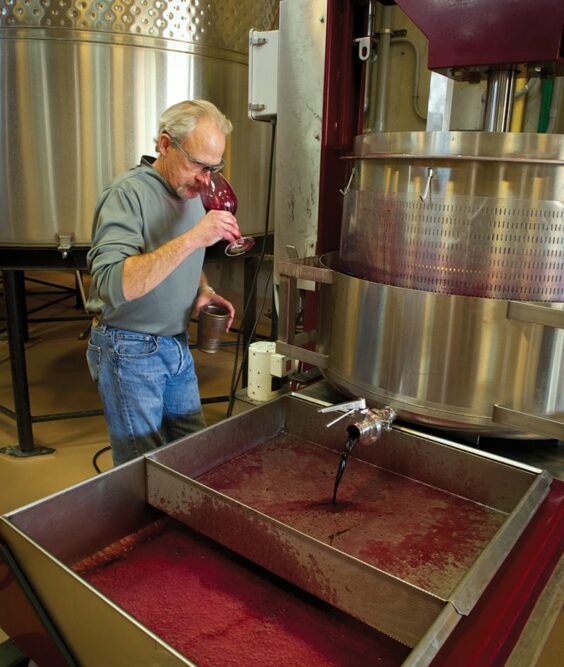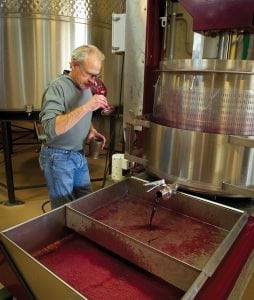
Home » Steady growth: Wine grape demand nearly outpaces supply
Steady growth: Wine grape demand nearly outpaces supply

May 6, 2018
Washington has developed a reputation for over-delivering on the quality of wine as it relates to the price of the bottle, creating an increasing demand for the state’s wine grapes.
“You can’t make good wine with bad grapes,” said Vicky Sharlau, executive director of the Washington Winegrowers Association.
In the past five years, acres dedicated to wine grapes have increased by 18 percent to 55,000 acres. A recent estimate from Ste. Michelle Wine Estates president and CEO Ted Baseler predicted the state has room for 200,000 acres of wine grapes. Getting to that figure wouldn’t just come from farming new land, as was the case on Red Mountain, but also by finding new groundwater opportunities or converting other crops to wine grapes.
“There’s no stopping Washington,” said Steve Warner, president of the Washington State Wine Commission. “We will become the No. 1 product in the state.” Apples currently boast the top ranking.
Warner pointed to Red Mountain’s barren land and sagebrush before it became a Washington wine hotspot, due to the high quality of fruit coming from this sub-American Viticultural Area, or AVA. It is part of the Yakima Valley AVA, and was identified in 2001. It now boasts 54 vineyards covering more than 2,300 acres.
AVAs identify designated wine grape-growing regions with unique and distinguishable geographic features. There are currently four applications for new Washington AVAs in the pipeline, including Candy Mountain in Benton County and White Bluffs in Franklin County. The two others include Klickitat and a portion of Adams and Grant counties.
“The addition of sub-AVAs is definitely a trend,” Sharlau said.
Wine experts say Washington’s all-important terroir is perfectly suited for wine grapes, from soils, mountain snowpack for irrigation water to a daily shift in temperatures that can be as much as 47 degrees during the growing season. When those grapes are ready to be harvested starting in mid-September, fall temperatures quickly set in, which helps lock in acidity, creating a better fruit for winemaking.
Despite these ideal conditions, Washington is still considered a fairly young player on the winemaking scene.
“It’s taken us a long time in Washington to realize we’re a wine state,” Sharlau said.
“It’s amazing that we didn’t figure this out sooner,” Warner said.
It took trial and error, combined with winemaking pioneers who set the bar high for the rest of the industry to follow.
“We have to constantly remind ourselves that even though we’re doing quite well and have huge growth potential, we’ve only been at it for a very short time when it compares to the global wine clock,” Warner said. “We’re still just on a first generation as compared to 25 generations elsewhere.”
Dick Boushey is one of those first-generation wine grape farmers. He moved to the Yakima Valley in the late ’70s and planted his first crops in 1980.
“At the time, wine grapes were sort of a sideline. They were not taken very seriously in the early years,” he said. He planted Concord juice grapes at the same time he planted wine grapes. He also was an apple and cherry farmer.

“When I first started, farmers looked at it as a novelty,” he said. “Like, ‘This will never really be established.’ Dr. Walter Clore had just finished his 10-year research project where he looked at 100 different wine grape varieties and people were trying to figure out what it meant.”
Boushey had to learn along with the rest of the growers.
“I planted Merlot in deep soil that was too fertile, where you really want leaner soils. It took me 10 years to figure out what I was doing, and then I’ve spent the last 25 years having to go back and re-educate myself,” he said.
Boushey recalled that lack of initial knowledge and insight was overcome by a willingness to learn. Since 1980, his vineyards have sold grapes to about 40 wineries; he manages multiple properties on Red Mountain; and has been named Grower of the Year by both the Washington State Wine Commission and Wine & Spirits magazine.
“My little career has grown with the wine industry,” he said.
The relationship between growers and winemakers is considered critical to the ongoing success of the industry.
“You see more vineyard-designated wines, growers’ names on bottles. That’s a testament to the quality of the grapes,” Sharlau said. “What other product do you buy that you can see where exactly it was grown and the name of the guy who did it?”
The partnership between grower and winemaker is underway well before the plants even go in the ground. The high value of Washington wine grapes mean the crop is not aimlessly planted and sold at harvest. Nearly everything is grown on a contract basis.
“This industry is really unique, unlike tree fruit. As a tree fruit grower, you grow it and put it in a bin and you take it to the packing shed or processor and that’s kind of the last time you see it,” Sharlau said. “With wine grapes, you have to have that delicate balance of supply and demand from grower all the way through winery. You can’t grow wine grapes and hope they go someplace.”
Growing wine grapes requires more constant care and oversight than juice grapes. While Concords are all about maximizing yield and production, wine grapes require a more detailed pruning and careful harvesting. This increases their value and puts an emphasis on tonnage versus acreage.
“You might get 10, 12, 14 tons of juice grapes per acre, but with wine grapes it could be two tons an acre,” Sharlau said. “There has to be an incentive to grow less.”
Based on acreage, about two-thirds of Washington’s wine grape crop is intended for red wines. The dominant varietals are Cabernet Sauvignon, Merlot and Syrah. Grapes grown for white wines make up the other third of Washington’s wine grape crop, including Chardonnay, Riesling and Pinot Gris. This is a market-driven change because not long ago Washington grew more grapes intended for white wines over red.
Despite Washington’s youth in the wine industry, there remains a strong optimism for continued success. Multiple experts used the same descriptor, citing a “bright future” ahead. There were 12 wineries when Boushey first began growing wine grapes, and now Washington boasts nearly a thousand. The state adds an average of two to three wineries each month, on a net basis in Washington.
“We’re not competing with each other, we’re competing with the world,” Boushey said.
Agriculture + Viticulture
KEYWORDS focus agriculture viticulture 2018





